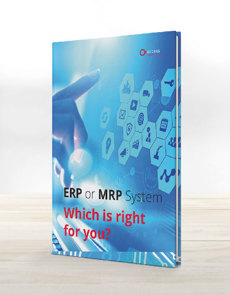What Is The Best MRP Software?
Read our handy guide on the best MRP software, and which will work best for your manufacturing business.
What Is MRP Software?
Material requirements planning (MRP) software is a system designed to help manufacturers calculate the type and quantity of materials they require, and when, for production.
These systems combine a range of processes in one centralised platform, including demand forecasting, scheduling, stock control and reporting functions. MRP software enables manufacturers to streamline stock management and reduce operational costs through greater efficiencies, while also maintaining end-to-end visibility of production and supply chains at all times.
It’s no surprise that MRP systems now sit at the heart of most modern manufacturing operations; however, finding the best MRP software to suit your particular needs isn’t always an easy task. Some systems are better suited to one type of production over others – which is why we’ve produced this handy guide to walk you through the options.
What Are The Different Types of MRP Software?
There are several types of MRP software available, each with its own set of pros and cons. The main types include:
1. On-premise MRP software – On-premise MRP software is installed and hosted locally on a business’ own servers. These systems generally offer greater control and customisation options as the software is managed in-house, also making it easier to keep control over data security.
However, on-premise systems usually require significant investment in IT infrastructure and staff. Ongoing maintenance and updates, as well as security and back ups, are the responsibility of the company, and that means employing a dedicated team to deploy new capabilities, keep pace with developments and stay on top of evolving compliance and security requirements.
2. Cloud-based MRP software – Unlike on-premise systems, cloud-based MRP software doesn’t require investment on-site servers or a dedicated IT support team. This is all taken care of by the vendor, which makes it easier, and often more affordable, for businesses to scale their system with business growth and adjust resources as needed.
Systems and data are available online 24/7, wherever you are.
With cloud-based systems, data is stored on a third-party server which some businesses may see as a disadvantage compared to having complete control over their servers. Manufacturers may also run into accessibility challenges if their internet connection isn’t reliable.
One clear advantage is that vendors are very likely to offer higher levels of security and protection than most manufacturers have in-house.
3. Hybrid MRP software – As the name suggests, hybrid MRP solutions combine aspects of both on-premise and cloud-based systems, allowing businesses to leverage the benefits of both. Hybrid systems typically give manufacturers the option to decide where certain data and processes are hosted, offering a balance between control and scalability.
On the other hand, managing hybrid systems can be more complex in terms of integration and ensuring seamless communication between on-site and off-site systems.
4. MRP II software – Whereas standard MRP software focuses primarily on stock management and ensuring materials are available when needed, MRP II systems expand on that with additional functions such as capacity planning, demand forecasting, financial management and shop floor control features.
You may think of MRP II as a midway point between MRP software and ERP software, with the latter offering a much more comprehensive solution which covers areas such as HR, payroll and other advanced functions.
Whereas cloud-based solutions are suitable for all sizes of manufacturing operations, on-premise solutions are more likely to be considered by large enterprises with complex processes that require total control, high security specifications e.g. defence, or advanced customisation capabilities. Hybrid solutions can offer a good middle ground; however, most organisations do prefer the simplicity of choosing between a cloud-based or on-premise solution.

What Are The Key Features of MRP Software?
Demand forecasting
Demand forecasting turns historical sales data, sales pipelines and market trends into useful insights that can be used to predict future demand for products. This helps manufacturers plan production schedules, procure materials, avoid stockouts and optimise stock levels – all of which leads to greater efficiency and customer satisfaction.
Advanced planning and scheduling
Advanced Planning and Scheduling (APS) functions allow manufacturers to create optimal production schedules based on labour, machinery capacity, resource availability and order priorities. A robust APS tool is crucial when it comes to reducing production costs and meeting delivery deadlines consistently.
Explore our advanced production planning and scheduling software >
Reporting
Being able to generate accurate, automated reports in just a few clicks is a huge advantage for manufacturers because it allows you to monitor and analyse KPIs throughout the production cycle. These real-time insights can help to flag up issues early, inform strategic decisions and ensure key day-to-day processes are on track.
Some MRP packages also offer analytics and dashboards, which can include data from finance and other systems. These allow you to visualise and interrogate the data to a different level.
Shop floor data capture
Shop floor data capture gives manufacturers full visibility over their production activities, including work orders, machinery usage, hours worked by employees and material consumption. This data feeds straight back into resource allocation and helps to avoid costly bottlenecks and inefficiencies in the production process.
Estimating and quotations
MRP software helps calculate material costs, labour costs, overhead expenses and other factors involved in producing a product. This ensures manufacturers can generate accurate and competitive quotes, negotiate contracts, manage customer expectations and establish long-term relationships with clients.
Sales order processing
Sales order processing facilitates the efficient handling of customer orders from receipt to fulfilment. Automating the sales order entry process takes a lot of the stress out of validating order details, checking inventory availability and generating order confirmations.
Purchase order processing
Purchase order processing enables manufacturers to manage procurement and supplier relationships more efficiently. It’s often used in tandem with sales order processing to ensure every base is covered when handling customer orders.
Stock control
Real-time visibility into inventory levels, stock movements and stock valuation helps minimise holding costs and prevents under or over-stocking. Effective stock control also serves to enhance order accuracy and overall supply chain efficiency.
Production order management
Production order management tools enable manufacturers to prioritise, schedule and track customer orders in line with materials, labour and machinery resources. This controls lead times and ensures an efficient utilisation of resources.
Traceability
Traceability functionality allows manufacturers to track and trace the movement of materials and finished products throughout the production process. Features include lot tracking, serial number tracking and batch tracking to ensure required product quality, compliance and supply chain transparency.
Job costing
MRP software captures all direct and indirect costs related to staff, materials, overheads and other expenses related to production. This enables manufacturers to calculate actual costs and compare that information against their initial forecast costs and take action if needed to protect and improve margins and profitability.
Other Things To Consider When Choosing MRP Software
Industry-specific considerations
The best MRP software solutions can be tailored to meet the unique needs of specific industries. For instance, automotive manufacturers with complex supply chains might require value added functions to support traceability and order control; whereas a food and beverage manufacturer may place extra emphasis on tracking expiration dates and compliance with food safety regulations; and an aerospace manufacturer may need to handle rapid product changes and stock materials for precision engineering. Medical devices manufacturers might require robust quality and traceability features to meet strict accreditations such as ISO 13485.
Scalability
Investing in an MRP system is a significant commitment for many businesses, and one that should be done with the long term and your growth ambitions in mind.
Cloud-based MRP software is a popular choice as it scales as your business grows, accommodating evolving production complexity and offering the option to integrate additional functionality as and when needed. This is vital to future-proof your investment in technology.
Integrations
Your business should be able to integrate MRP software seamlessly with other core systems like ERP, Finance, CRM and HR software. The end goal is to facilitate seamless data flows between different departments, eliminating the need for manual data entry and improving accuracy of information across your entire organisation - for a holistic view of your operations and performance.
Training and support
Ideally, your choice of MRP software should be user-friendly and easy to use, even for employees that don’t have a high level of digital literacy.
Not all systems are backed up by exceptional support teams or offer comprehensive training for employees, which is why it’s important to find a vendor that provides initial training and ongoing support for your MRP platform. Otherwise, you may not be able to make the most of your investment and achieve ROI.
What Are The Best MRP Software Solutions Available?
MRPeasy
MRPeasy is a cloud-based MRP system aimed at small and growing manufacturers. It offers a user-friendly interface and covers core MRP functionalities.
Pros: Accessible UX design, remote access, affordable for small manufacturers
Cons: Limited in terms of scalability, integration and functionality for more complex manufacturing operations
Odoo
Odoo is an open-source ERP system with a wide range of modules, including MRP. It's known for its flexibility and customization options.
Pros: Large community of open-source developers, easy to add and integrate new modules
Cons: Lack of professional support team, can be complex to set up and configure depending on in-house expertise
JobBOSS
JobBOSS is an ERP system designed for job shops and make-to-order manufacturers. The software’s MRP features include quoting, scheduling, inventory management and more.
Pros: Targets specific needs of job shop manufacturers, integrates with wider ERP system, good customisation options
Cons: Extra charges to make changes, clients mention difficulties with legacy interface and initial training
E-Max Systems
E-Max’s ERP system features an integrated MRP system at its core that allows users to manage the processes of quotes, stock control, production and quality control. The system was built with manufacturing and engineering SMEs in mind.
Pros: Designed to scale with business growth, good visibility of operations and inventory control
Cons: Not very user-friendly, takes time to get up to speed, lacks customisation abilities
WinMan
WinMan is an all-in-one ERP solution which provides visibility of data across the business, empowering people to make informed, timely decisions. WinMan supports a range of companies that have complex MRP and distribution requirements.
Pros: Good inventory forecasting function, integrates well with website and other data flows, user-friendly interface
Cons: Not suitable for larger enterprises with more complex requirements, doesn’t integrate with payroll
Access FactoryMaster
Access FactoryMaster is an MRP solution designed for small to medium manufacturers. The system is quick to deploy and integrates seamlessly with key financial software solutions.
The software supports a wide range of different industries, allowing you to gain control of your end-to-end purchasing, production and full visibility over stock levels. Key features include: estimating and quotations, traceability, shop floor data capture, job costings and stock control.
Pros: Full end-to-end MRP capabilities and user-friendly analytics dashboards; intuitive inventory management and demand forecasting systems, strong data reporting function
Cons: No free version available, cost may be a challenge for smaller companies
Best MRP software comparison table
Why choose Access manufacturing software?
Access manufacturing software is an end-to-end solution that boosts your bottom line. It's designed to join the dots across your manufacturing operations to give you complete visibility.
- Material requirements planning (MRP)
- Production planning and scheduling
- Business management
- Operations management
- Reporting and analytics
- and more!
Trusted by over 500 manufacturing businesses. See how it could benefit your business today.

 AU & NZ
AU & NZ
 SG
SG
 MY
MY
 US
US
 IE
IE







